Opportunities and Challenges of Business Innovations: A Case Study of Myers and David Jones Group
VerifiedAdded on 2023/06/12
|15
|2655
|252
AI Summary
This case study analyzes the opportunities and challenges of business innovations in the retail industry, with a focus on Myers and David Jones Group. It covers research methodology, data collection and analysis techniques, and research limitations.
Contribute Materials
Your contribution can guide someone’s learning journey. Share your
documents today.
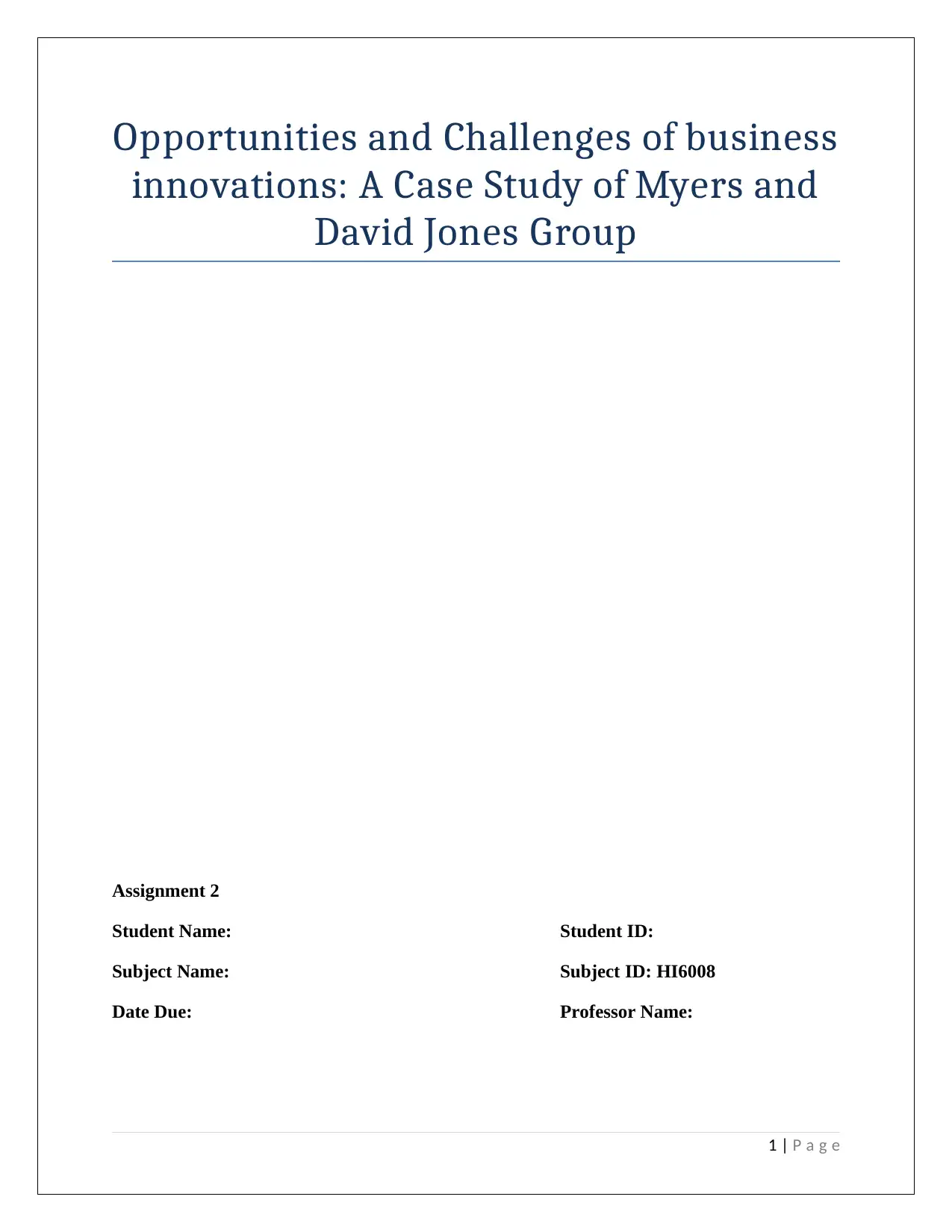
Opportunities and Challenges of business
innovations: A Case Study of Myers and
David Jones Group
Assignment 2
Student Name: Student ID:
Subject Name: Subject ID: HI6008
Date Due: Professor Name:
1 | P a g e
innovations: A Case Study of Myers and
David Jones Group
Assignment 2
Student Name: Student ID:
Subject Name: Subject ID: HI6008
Date Due: Professor Name:
1 | P a g e
Secure Best Marks with AI Grader
Need help grading? Try our AI Grader for instant feedback on your assignments.

Executive Summary
In order to conduct any study it becomes critical to define a research philosophy and
approach. It allows entailing data collection procedure and analysis techniques for the same. The
scope of the current study is a continuation of study undertaken for Myers and David Jones
groups and deals with research procedure for the same.
2 | P a g e
In order to conduct any study it becomes critical to define a research philosophy and
approach. It allows entailing data collection procedure and analysis techniques for the same. The
scope of the current study is a continuation of study undertaken for Myers and David Jones
groups and deals with research procedure for the same.
2 | P a g e
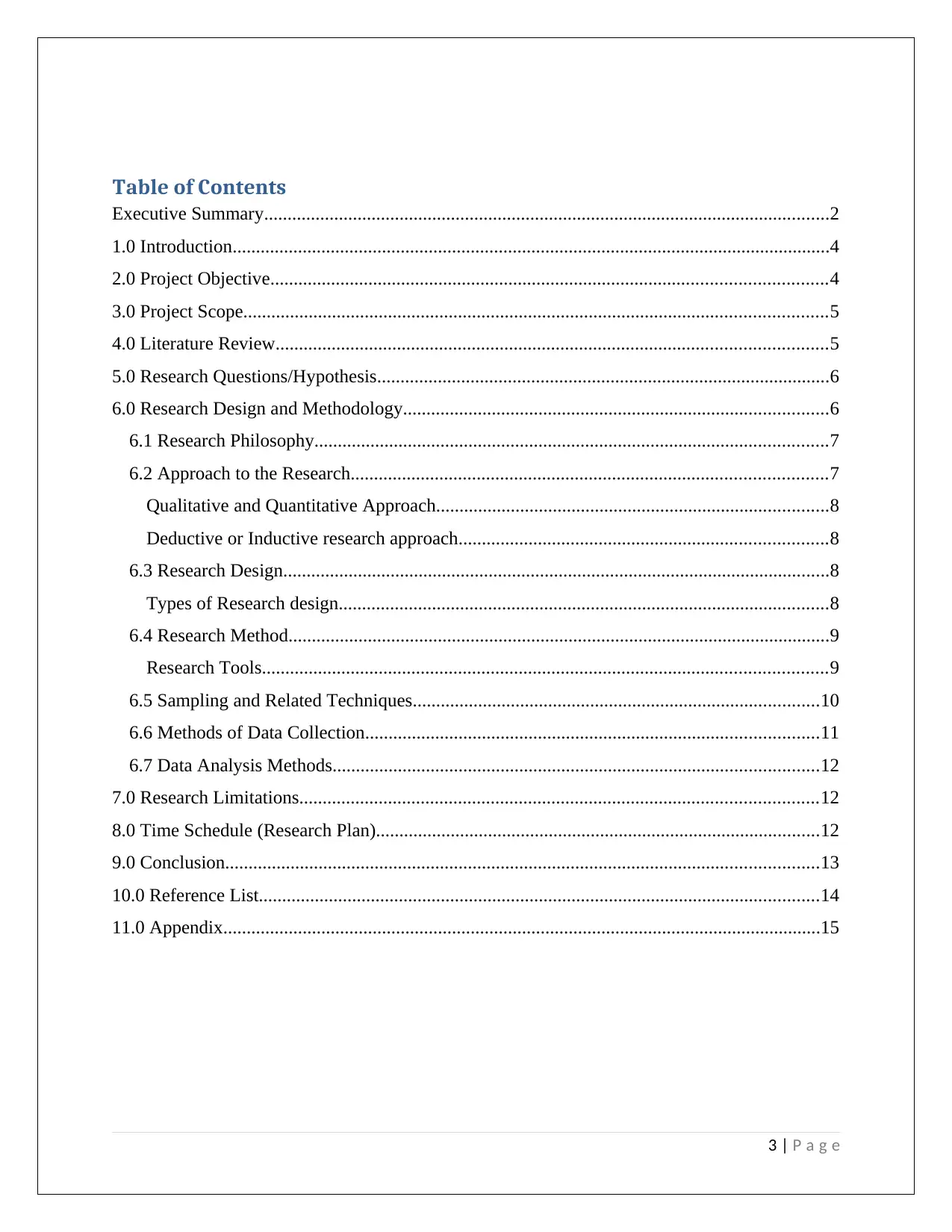
Table of Contents
Executive Summary.........................................................................................................................2
1.0 Introduction................................................................................................................................4
2.0 Project Objective.......................................................................................................................4
3.0 Project Scope.............................................................................................................................5
4.0 Literature Review......................................................................................................................5
5.0 Research Questions/Hypothesis.................................................................................................6
6.0 Research Design and Methodology...........................................................................................6
6.1 Research Philosophy..............................................................................................................7
6.2 Approach to the Research......................................................................................................7
Qualitative and Quantitative Approach....................................................................................8
Deductive or Inductive research approach...............................................................................8
6.3 Research Design.....................................................................................................................8
Types of Research design.........................................................................................................8
6.4 Research Method....................................................................................................................9
Research Tools.........................................................................................................................9
6.5 Sampling and Related Techniques.......................................................................................10
6.6 Methods of Data Collection.................................................................................................11
6.7 Data Analysis Methods........................................................................................................12
7.0 Research Limitations...............................................................................................................12
8.0 Time Schedule (Research Plan)...............................................................................................12
9.0 Conclusion...............................................................................................................................13
10.0 Reference List........................................................................................................................14
11.0 Appendix................................................................................................................................15
3 | P a g e
Executive Summary.........................................................................................................................2
1.0 Introduction................................................................................................................................4
2.0 Project Objective.......................................................................................................................4
3.0 Project Scope.............................................................................................................................5
4.0 Literature Review......................................................................................................................5
5.0 Research Questions/Hypothesis.................................................................................................6
6.0 Research Design and Methodology...........................................................................................6
6.1 Research Philosophy..............................................................................................................7
6.2 Approach to the Research......................................................................................................7
Qualitative and Quantitative Approach....................................................................................8
Deductive or Inductive research approach...............................................................................8
6.3 Research Design.....................................................................................................................8
Types of Research design.........................................................................................................8
6.4 Research Method....................................................................................................................9
Research Tools.........................................................................................................................9
6.5 Sampling and Related Techniques.......................................................................................10
6.6 Methods of Data Collection.................................................................................................11
6.7 Data Analysis Methods........................................................................................................12
7.0 Research Limitations...............................................................................................................12
8.0 Time Schedule (Research Plan)...............................................................................................12
9.0 Conclusion...............................................................................................................................13
10.0 Reference List........................................................................................................................14
11.0 Appendix................................................................................................................................15
3 | P a g e
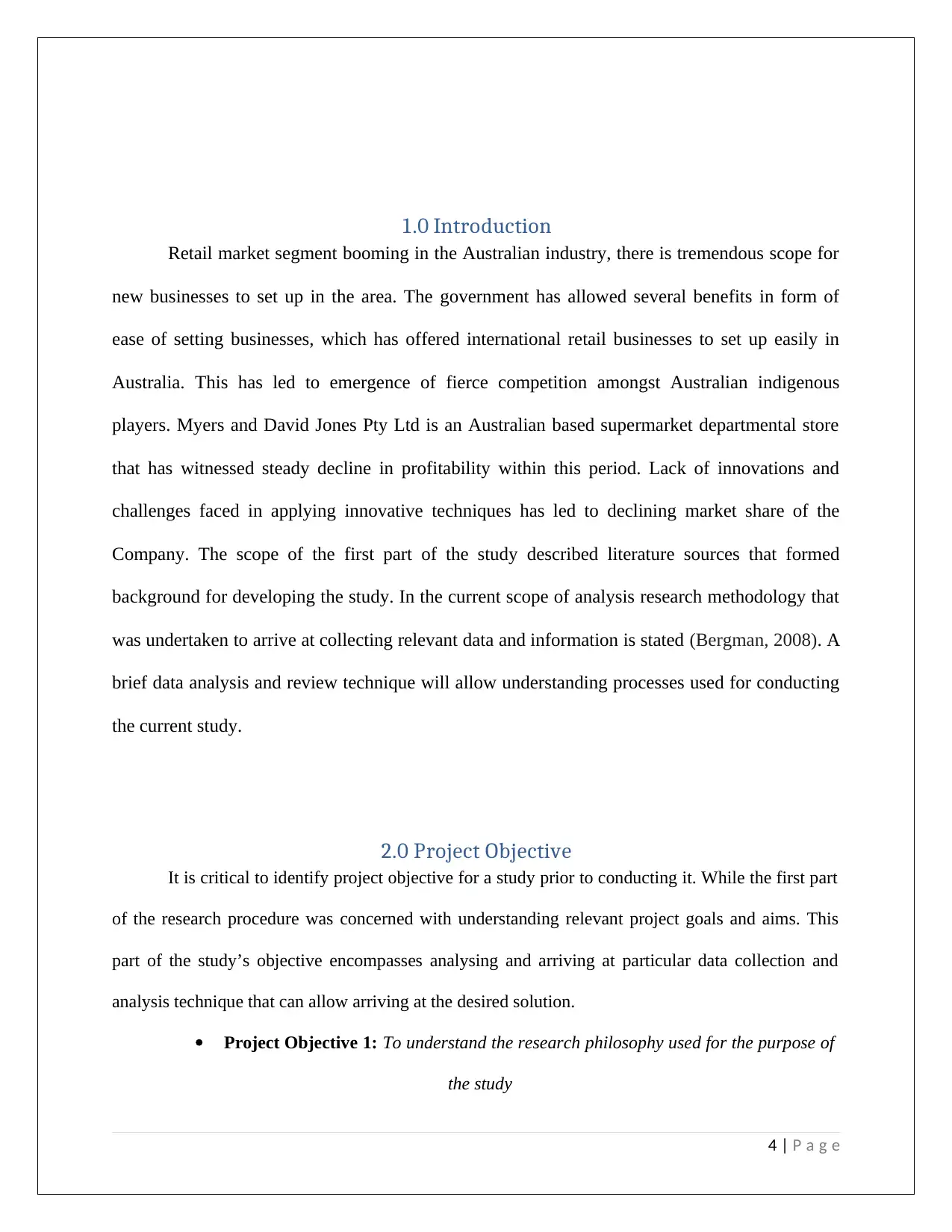
1.0 Introduction
Retail market segment booming in the Australian industry, there is tremendous scope for
new businesses to set up in the area. The government has allowed several benefits in form of
ease of setting businesses, which has offered international retail businesses to set up easily in
Australia. This has led to emergence of fierce competition amongst Australian indigenous
players. Myers and David Jones Pty Ltd is an Australian based supermarket departmental store
that has witnessed steady decline in profitability within this period. Lack of innovations and
challenges faced in applying innovative techniques has led to declining market share of the
Company. The scope of the first part of the study described literature sources that formed
background for developing the study. In the current scope of analysis research methodology that
was undertaken to arrive at collecting relevant data and information is stated (Bergman, 2008). A
brief data analysis and review technique will allow understanding processes used for conducting
the current study.
2.0 Project Objective
It is critical to identify project objective for a study prior to conducting it. While the first part
of the research procedure was concerned with understanding relevant project goals and aims. This
part of the study’s objective encompasses analysing and arriving at particular data collection and
analysis technique that can allow arriving at the desired solution.
Project Objective 1: To understand the research philosophy used for the purpose of
the study
4 | P a g e
Retail market segment booming in the Australian industry, there is tremendous scope for
new businesses to set up in the area. The government has allowed several benefits in form of
ease of setting businesses, which has offered international retail businesses to set up easily in
Australia. This has led to emergence of fierce competition amongst Australian indigenous
players. Myers and David Jones Pty Ltd is an Australian based supermarket departmental store
that has witnessed steady decline in profitability within this period. Lack of innovations and
challenges faced in applying innovative techniques has led to declining market share of the
Company. The scope of the first part of the study described literature sources that formed
background for developing the study. In the current scope of analysis research methodology that
was undertaken to arrive at collecting relevant data and information is stated (Bergman, 2008). A
brief data analysis and review technique will allow understanding processes used for conducting
the current study.
2.0 Project Objective
It is critical to identify project objective for a study prior to conducting it. While the first part
of the research procedure was concerned with understanding relevant project goals and aims. This
part of the study’s objective encompasses analysing and arriving at particular data collection and
analysis technique that can allow arriving at the desired solution.
Project Objective 1: To understand the research philosophy used for the purpose of
the study
4 | P a g e
Secure Best Marks with AI Grader
Need help grading? Try our AI Grader for instant feedback on your assignments.
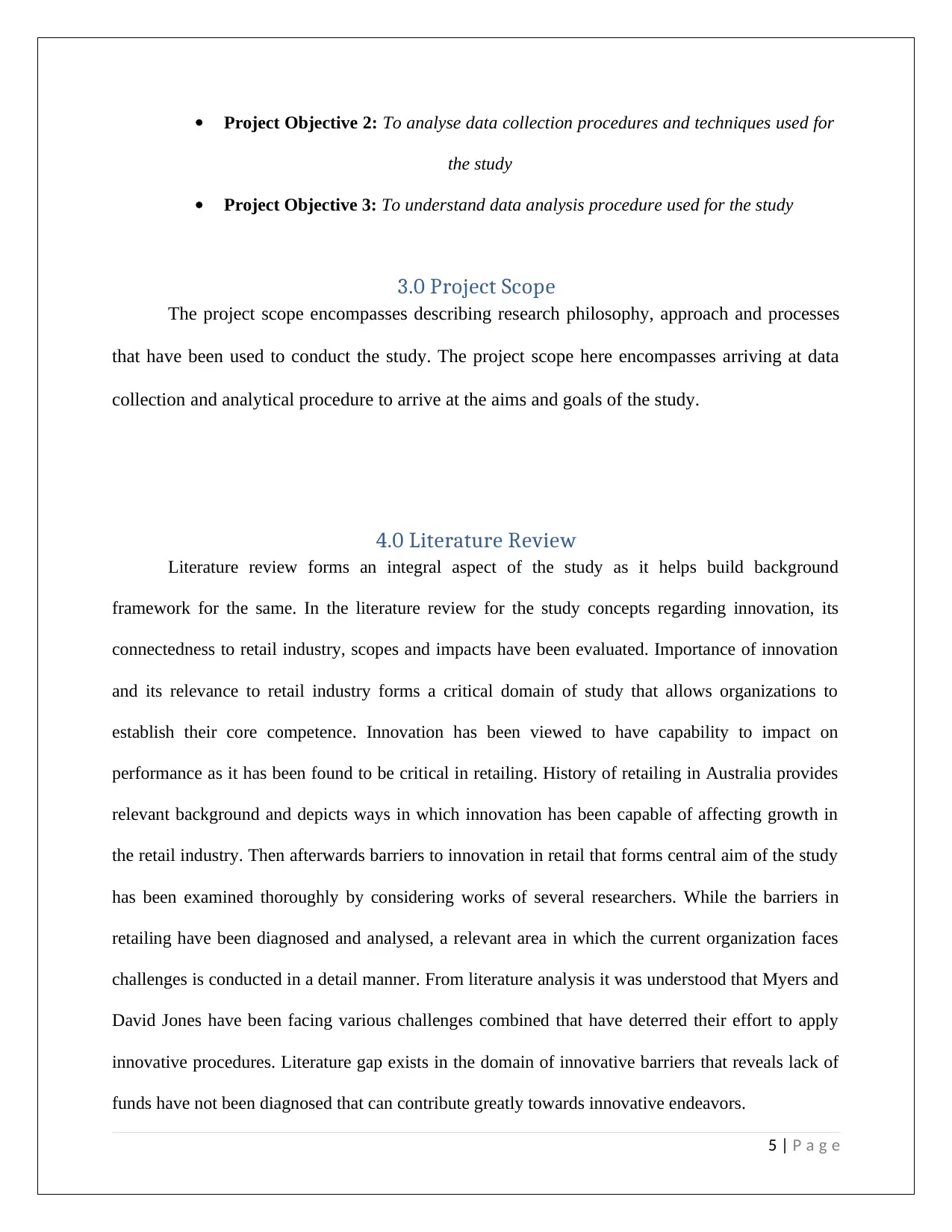
Project Objective 2: To analyse data collection procedures and techniques used for
the study
Project Objective 3: To understand data analysis procedure used for the study
3.0 Project Scope
The project scope encompasses describing research philosophy, approach and processes
that have been used to conduct the study. The project scope here encompasses arriving at data
collection and analytical procedure to arrive at the aims and goals of the study.
4.0 Literature Review
Literature review forms an integral aspect of the study as it helps build background
framework for the same. In the literature review for the study concepts regarding innovation, its
connectedness to retail industry, scopes and impacts have been evaluated. Importance of innovation
and its relevance to retail industry forms a critical domain of study that allows organizations to
establish their core competence. Innovation has been viewed to have capability to impact on
performance as it has been found to be critical in retailing. History of retailing in Australia provides
relevant background and depicts ways in which innovation has been capable of affecting growth in
the retail industry. Then afterwards barriers to innovation in retail that forms central aim of the study
has been examined thoroughly by considering works of several researchers. While the barriers in
retailing have been diagnosed and analysed, a relevant area in which the current organization faces
challenges is conducted in a detail manner. From literature analysis it was understood that Myers and
David Jones have been facing various challenges combined that have deterred their effort to apply
innovative procedures. Literature gap exists in the domain of innovative barriers that reveals lack of
funds have not been diagnosed that can contribute greatly towards innovative endeavors.
5 | P a g e
the study
Project Objective 3: To understand data analysis procedure used for the study
3.0 Project Scope
The project scope encompasses describing research philosophy, approach and processes
that have been used to conduct the study. The project scope here encompasses arriving at data
collection and analytical procedure to arrive at the aims and goals of the study.
4.0 Literature Review
Literature review forms an integral aspect of the study as it helps build background
framework for the same. In the literature review for the study concepts regarding innovation, its
connectedness to retail industry, scopes and impacts have been evaluated. Importance of innovation
and its relevance to retail industry forms a critical domain of study that allows organizations to
establish their core competence. Innovation has been viewed to have capability to impact on
performance as it has been found to be critical in retailing. History of retailing in Australia provides
relevant background and depicts ways in which innovation has been capable of affecting growth in
the retail industry. Then afterwards barriers to innovation in retail that forms central aim of the study
has been examined thoroughly by considering works of several researchers. While the barriers in
retailing have been diagnosed and analysed, a relevant area in which the current organization faces
challenges is conducted in a detail manner. From literature analysis it was understood that Myers and
David Jones have been facing various challenges combined that have deterred their effort to apply
innovative procedures. Literature gap exists in the domain of innovative barriers that reveals lack of
funds have not been diagnosed that can contribute greatly towards innovative endeavors.
5 | P a g e
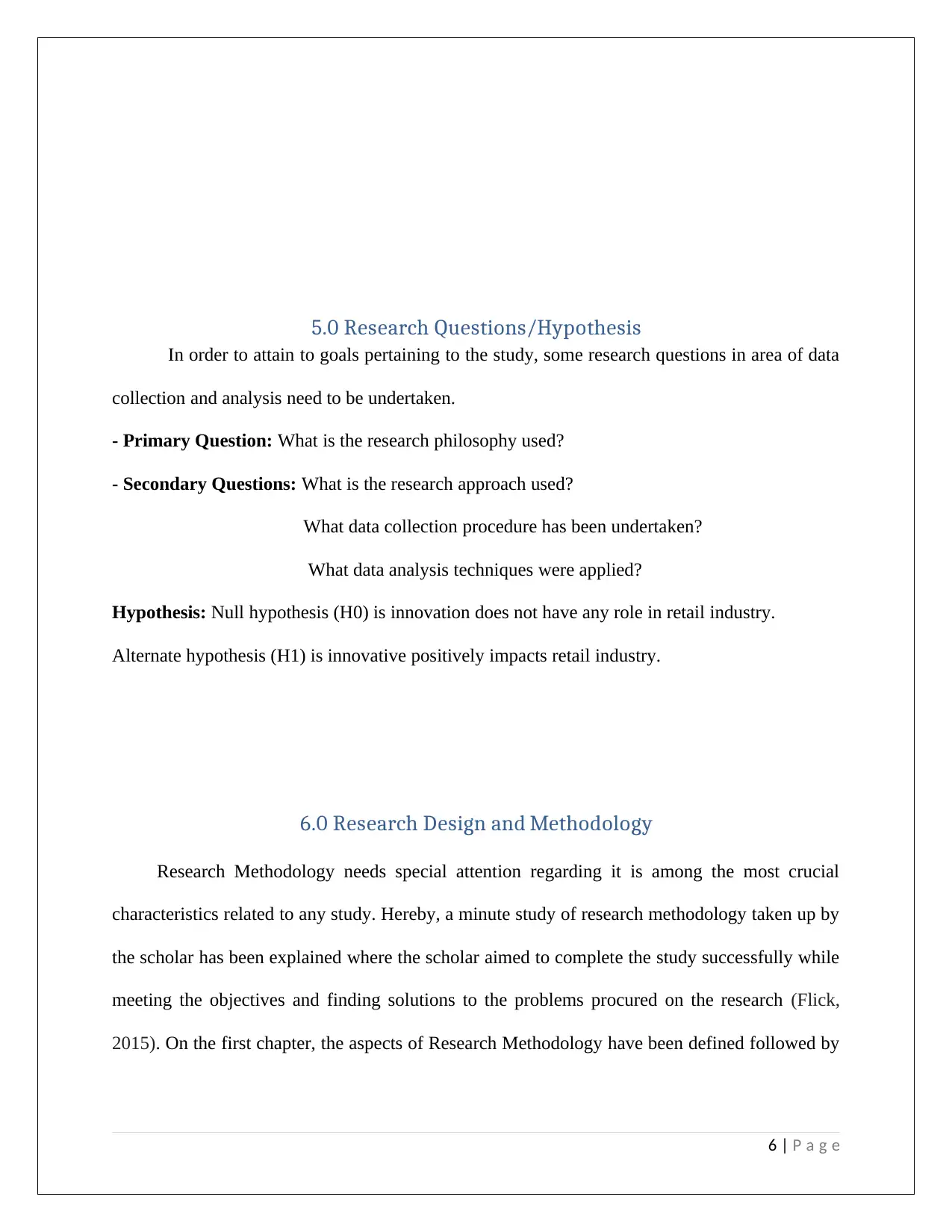
5.0 Research Questions/Hypothesis
In order to attain to goals pertaining to the study, some research questions in area of data
collection and analysis need to be undertaken.
- Primary Question: What is the research philosophy used?
- Secondary Questions: What is the research approach used?
What data collection procedure has been undertaken?
What data analysis techniques were applied?
Hypothesis: Null hypothesis (H0) is innovation does not have any role in retail industry.
Alternate hypothesis (H1) is innovative positively impacts retail industry.
6.0 Research Design and Methodology
Research Methodology needs special attention regarding it is among the most crucial
characteristics related to any study. Hereby, a minute study of research methodology taken up by
the scholar has been explained where the scholar aimed to complete the study successfully while
meeting the objectives and finding solutions to the problems procured on the research (Flick,
2015). On the first chapter, the aspects of Research Methodology have been defined followed by
6 | P a g e
In order to attain to goals pertaining to the study, some research questions in area of data
collection and analysis need to be undertaken.
- Primary Question: What is the research philosophy used?
- Secondary Questions: What is the research approach used?
What data collection procedure has been undertaken?
What data analysis techniques were applied?
Hypothesis: Null hypothesis (H0) is innovation does not have any role in retail industry.
Alternate hypothesis (H1) is innovative positively impacts retail industry.
6.0 Research Design and Methodology
Research Methodology needs special attention regarding it is among the most crucial
characteristics related to any study. Hereby, a minute study of research methodology taken up by
the scholar has been explained where the scholar aimed to complete the study successfully while
meeting the objectives and finding solutions to the problems procured on the research (Flick,
2015). On the first chapter, the aspects of Research Methodology have been defined followed by
6 | P a g e
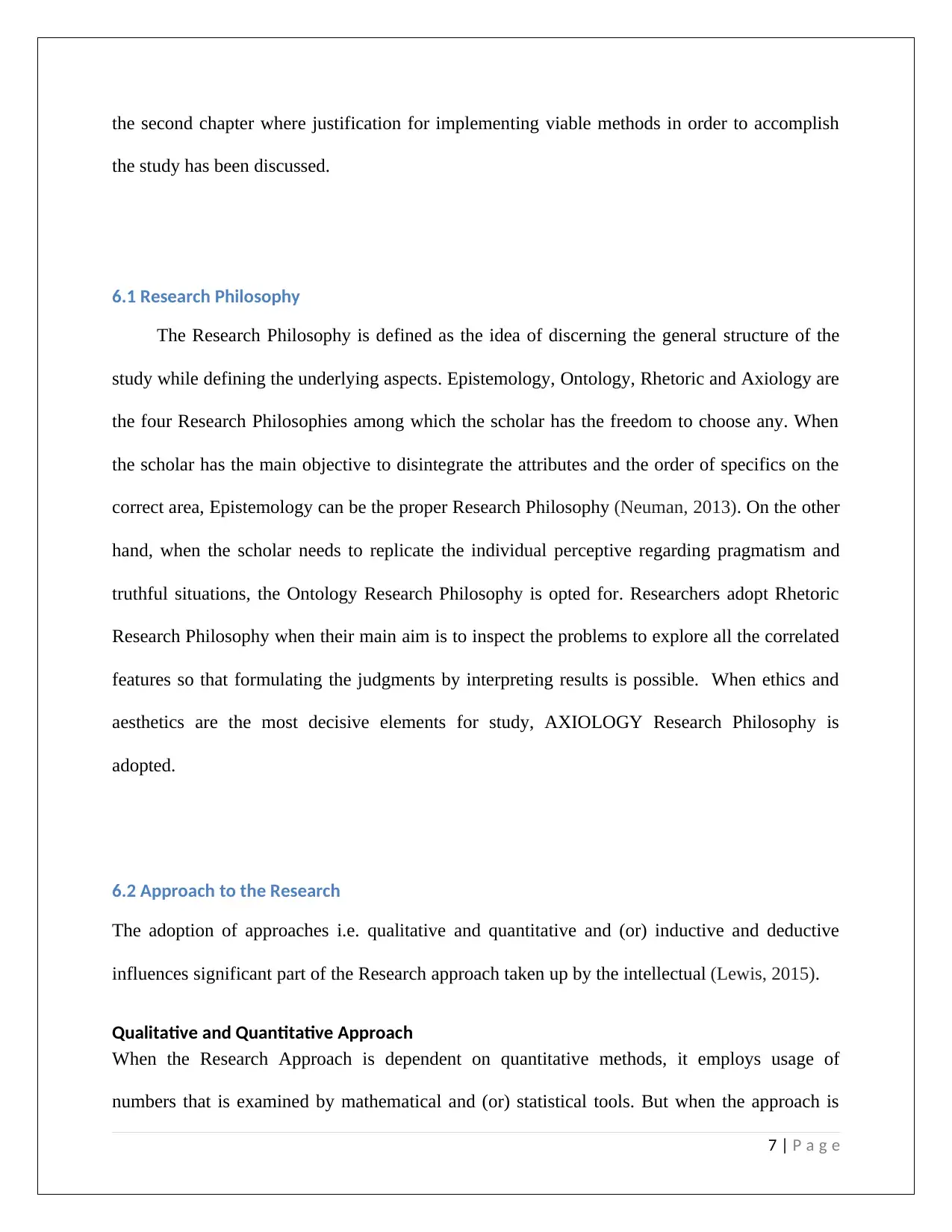
the second chapter where justification for implementing viable methods in order to accomplish
the study has been discussed.
6.1 Research Philosophy
The Research Philosophy is defined as the idea of discerning the general structure of the
study while defining the underlying aspects. Epistemology, Ontology, Rhetoric and Axiology are
the four Research Philosophies among which the scholar has the freedom to choose any. When
the scholar has the main objective to disintegrate the attributes and the order of specifics on the
correct area, Epistemology can be the proper Research Philosophy (Neuman, 2013). On the other
hand, when the scholar needs to replicate the individual perceptive regarding pragmatism and
truthful situations, the Ontology Research Philosophy is opted for. Researchers adopt Rhetoric
Research Philosophy when their main aim is to inspect the problems to explore all the correlated
features so that formulating the judgments by interpreting results is possible. When ethics and
aesthetics are the most decisive elements for study, AXIOLOGY Research Philosophy is
adopted.
6.2 Approach to the Research
The adoption of approaches i.e. qualitative and quantitative and (or) inductive and deductive
influences significant part of the Research approach taken up by the intellectual (Lewis, 2015).
Qualitative and Quantitative Approach
When the Research Approach is dependent on quantitative methods, it employs usage of
numbers that is examined by mathematical and (or) statistical tools. But when the approach is
7 | P a g e
the study has been discussed.
6.1 Research Philosophy
The Research Philosophy is defined as the idea of discerning the general structure of the
study while defining the underlying aspects. Epistemology, Ontology, Rhetoric and Axiology are
the four Research Philosophies among which the scholar has the freedom to choose any. When
the scholar has the main objective to disintegrate the attributes and the order of specifics on the
correct area, Epistemology can be the proper Research Philosophy (Neuman, 2013). On the other
hand, when the scholar needs to replicate the individual perceptive regarding pragmatism and
truthful situations, the Ontology Research Philosophy is opted for. Researchers adopt Rhetoric
Research Philosophy when their main aim is to inspect the problems to explore all the correlated
features so that formulating the judgments by interpreting results is possible. When ethics and
aesthetics are the most decisive elements for study, AXIOLOGY Research Philosophy is
adopted.
6.2 Approach to the Research
The adoption of approaches i.e. qualitative and quantitative and (or) inductive and deductive
influences significant part of the Research approach taken up by the intellectual (Lewis, 2015).
Qualitative and Quantitative Approach
When the Research Approach is dependent on quantitative methods, it employs usage of
numbers that is examined by mathematical and (or) statistical tools. But when the approach is
7 | P a g e
Paraphrase This Document
Need a fresh take? Get an instant paraphrase of this document with our AI Paraphraser
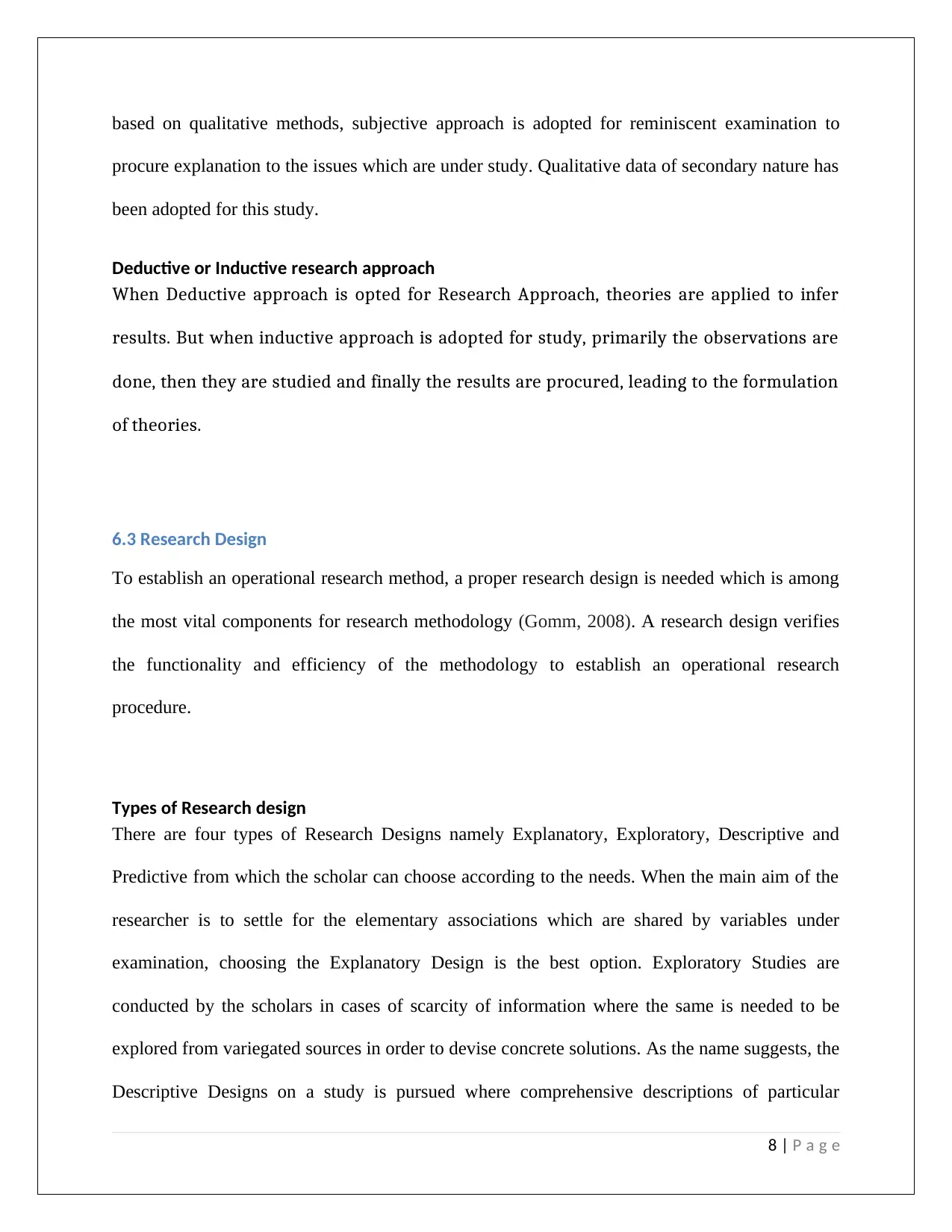
based on qualitative methods, subjective approach is adopted for reminiscent examination to
procure explanation to the issues which are under study. Qualitative data of secondary nature has
been adopted for this study.
Deductive or Inductive research approach
When Deductive approach is opted for Research Approach, theories are applied to infer
results. But when inductive approach is adopted for study, primarily the observations are
done, then they are studied and finally the results are procured, leading to the formulation
of theories.
6.3 Research Design
To establish an operational research method, a proper research design is needed which is among
the most vital components for research methodology (Gomm, 2008). A research design verifies
the functionality and efficiency of the methodology to establish an operational research
procedure.
Types of Research design
There are four types of Research Designs namely Explanatory, Exploratory, Descriptive and
Predictive from which the scholar can choose according to the needs. When the main aim of the
researcher is to settle for the elementary associations which are shared by variables under
examination, choosing the Explanatory Design is the best option. Exploratory Studies are
conducted by the scholars in cases of scarcity of information where the same is needed to be
explored from variegated sources in order to devise concrete solutions. As the name suggests, the
Descriptive Designs on a study is pursued where comprehensive descriptions of particular
8 | P a g e
procure explanation to the issues which are under study. Qualitative data of secondary nature has
been adopted for this study.
Deductive or Inductive research approach
When Deductive approach is opted for Research Approach, theories are applied to infer
results. But when inductive approach is adopted for study, primarily the observations are
done, then they are studied and finally the results are procured, leading to the formulation
of theories.
6.3 Research Design
To establish an operational research method, a proper research design is needed which is among
the most vital components for research methodology (Gomm, 2008). A research design verifies
the functionality and efficiency of the methodology to establish an operational research
procedure.
Types of Research design
There are four types of Research Designs namely Explanatory, Exploratory, Descriptive and
Predictive from which the scholar can choose according to the needs. When the main aim of the
researcher is to settle for the elementary associations which are shared by variables under
examination, choosing the Explanatory Design is the best option. Exploratory Studies are
conducted by the scholars in cases of scarcity of information where the same is needed to be
explored from variegated sources in order to devise concrete solutions. As the name suggests, the
Descriptive Designs on a study is pursued where comprehensive descriptions of particular
8 | P a g e
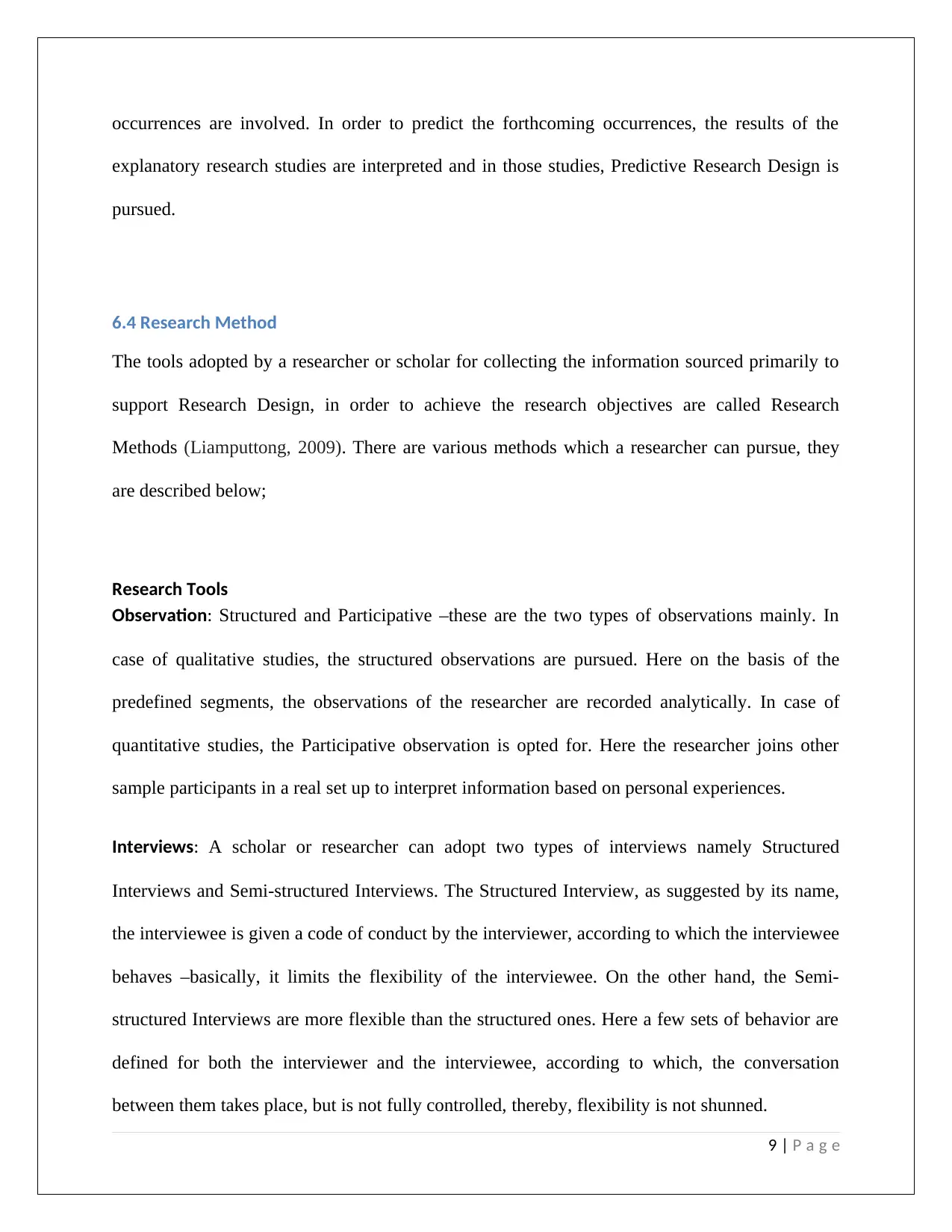
occurrences are involved. In order to predict the forthcoming occurrences, the results of the
explanatory research studies are interpreted and in those studies, Predictive Research Design is
pursued.
6.4 Research Method
The tools adopted by a researcher or scholar for collecting the information sourced primarily to
support Research Design, in order to achieve the research objectives are called Research
Methods (Liamputtong, 2009). There are various methods which a researcher can pursue, they
are described below;
Research Tools
Observation: Structured and Participative –these are the two types of observations mainly. In
case of qualitative studies, the structured observations are pursued. Here on the basis of the
predefined segments, the observations of the researcher are recorded analytically. In case of
quantitative studies, the Participative observation is opted for. Here the researcher joins other
sample participants in a real set up to interpret information based on personal experiences.
Interviews: A scholar or researcher can adopt two types of interviews namely Structured
Interviews and Semi-structured Interviews. The Structured Interview, as suggested by its name,
the interviewee is given a code of conduct by the interviewer, according to which the interviewee
behaves –basically, it limits the flexibility of the interviewee. On the other hand, the Semi-
structured Interviews are more flexible than the structured ones. Here a few sets of behavior are
defined for both the interviewer and the interviewee, according to which, the conversation
between them takes place, but is not fully controlled, thereby, flexibility is not shunned.
9 | P a g e
explanatory research studies are interpreted and in those studies, Predictive Research Design is
pursued.
6.4 Research Method
The tools adopted by a researcher or scholar for collecting the information sourced primarily to
support Research Design, in order to achieve the research objectives are called Research
Methods (Liamputtong, 2009). There are various methods which a researcher can pursue, they
are described below;
Research Tools
Observation: Structured and Participative –these are the two types of observations mainly. In
case of qualitative studies, the structured observations are pursued. Here on the basis of the
predefined segments, the observations of the researcher are recorded analytically. In case of
quantitative studies, the Participative observation is opted for. Here the researcher joins other
sample participants in a real set up to interpret information based on personal experiences.
Interviews: A scholar or researcher can adopt two types of interviews namely Structured
Interviews and Semi-structured Interviews. The Structured Interview, as suggested by its name,
the interviewee is given a code of conduct by the interviewer, according to which the interviewee
behaves –basically, it limits the flexibility of the interviewee. On the other hand, the Semi-
structured Interviews are more flexible than the structured ones. Here a few sets of behavior are
defined for both the interviewer and the interviewee, according to which, the conversation
between them takes place, but is not fully controlled, thereby, flexibility is not shunned.
9 | P a g e
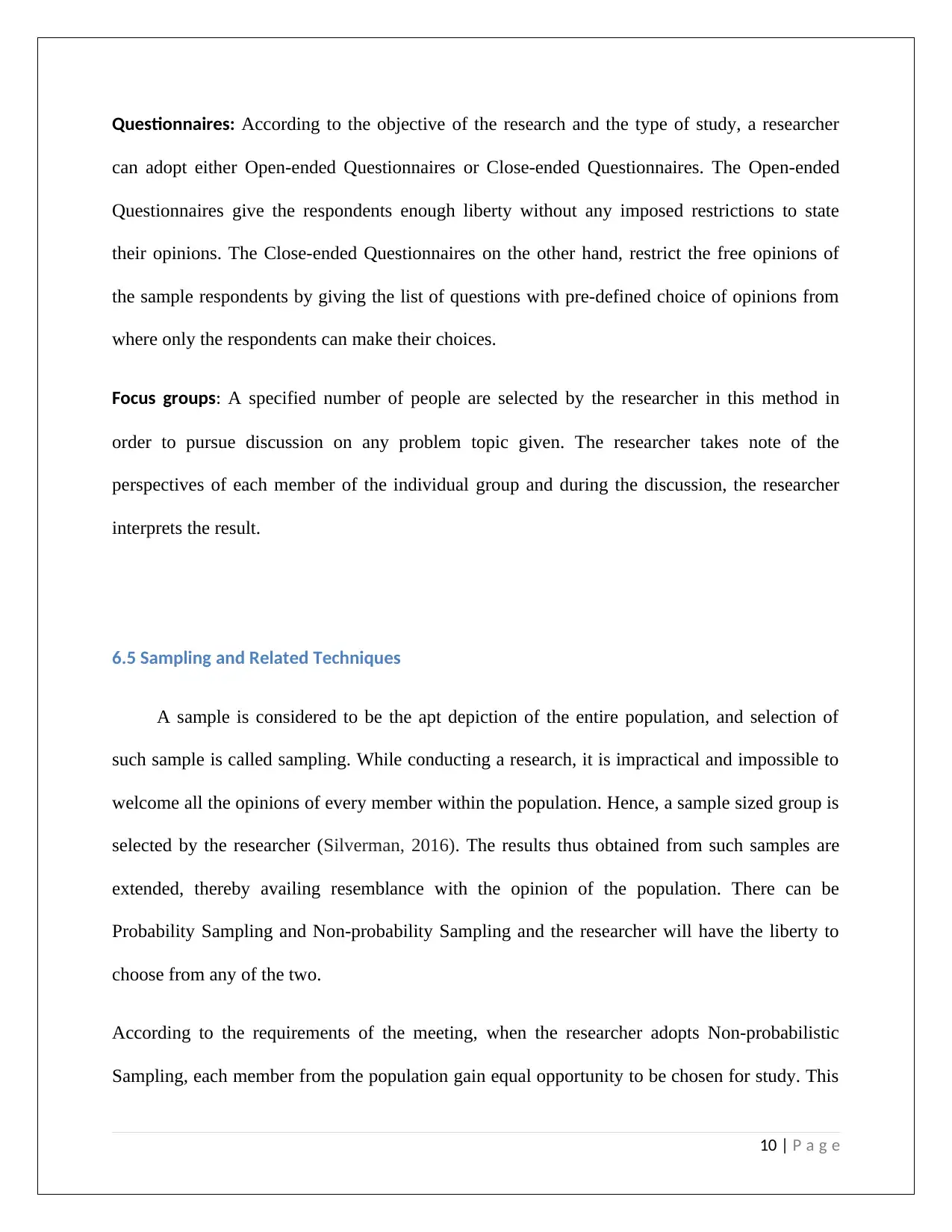
Questionnaires: According to the objective of the research and the type of study, a researcher
can adopt either Open-ended Questionnaires or Close-ended Questionnaires. The Open-ended
Questionnaires give the respondents enough liberty without any imposed restrictions to state
their opinions. The Close-ended Questionnaires on the other hand, restrict the free opinions of
the sample respondents by giving the list of questions with pre-defined choice of opinions from
where only the respondents can make their choices.
Focus groups: A specified number of people are selected by the researcher in this method in
order to pursue discussion on any problem topic given. The researcher takes note of the
perspectives of each member of the individual group and during the discussion, the researcher
interprets the result.
6.5 Sampling and Related Techniques
A sample is considered to be the apt depiction of the entire population, and selection of
such sample is called sampling. While conducting a research, it is impractical and impossible to
welcome all the opinions of every member within the population. Hence, a sample sized group is
selected by the researcher (Silverman, 2016). The results thus obtained from such samples are
extended, thereby availing resemblance with the opinion of the population. There can be
Probability Sampling and Non-probability Sampling and the researcher will have the liberty to
choose from any of the two.
According to the requirements of the meeting, when the researcher adopts Non-probabilistic
Sampling, each member from the population gain equal opportunity to be chosen for study. This
10 | P a g e
can adopt either Open-ended Questionnaires or Close-ended Questionnaires. The Open-ended
Questionnaires give the respondents enough liberty without any imposed restrictions to state
their opinions. The Close-ended Questionnaires on the other hand, restrict the free opinions of
the sample respondents by giving the list of questions with pre-defined choice of opinions from
where only the respondents can make their choices.
Focus groups: A specified number of people are selected by the researcher in this method in
order to pursue discussion on any problem topic given. The researcher takes note of the
perspectives of each member of the individual group and during the discussion, the researcher
interprets the result.
6.5 Sampling and Related Techniques
A sample is considered to be the apt depiction of the entire population, and selection of
such sample is called sampling. While conducting a research, it is impractical and impossible to
welcome all the opinions of every member within the population. Hence, a sample sized group is
selected by the researcher (Silverman, 2016). The results thus obtained from such samples are
extended, thereby availing resemblance with the opinion of the population. There can be
Probability Sampling and Non-probability Sampling and the researcher will have the liberty to
choose from any of the two.
According to the requirements of the meeting, when the researcher adopts Non-probabilistic
Sampling, each member from the population gain equal opportunity to be chosen for study. This
10 | P a g e
Secure Best Marks with AI Grader
Need help grading? Try our AI Grader for instant feedback on your assignments.
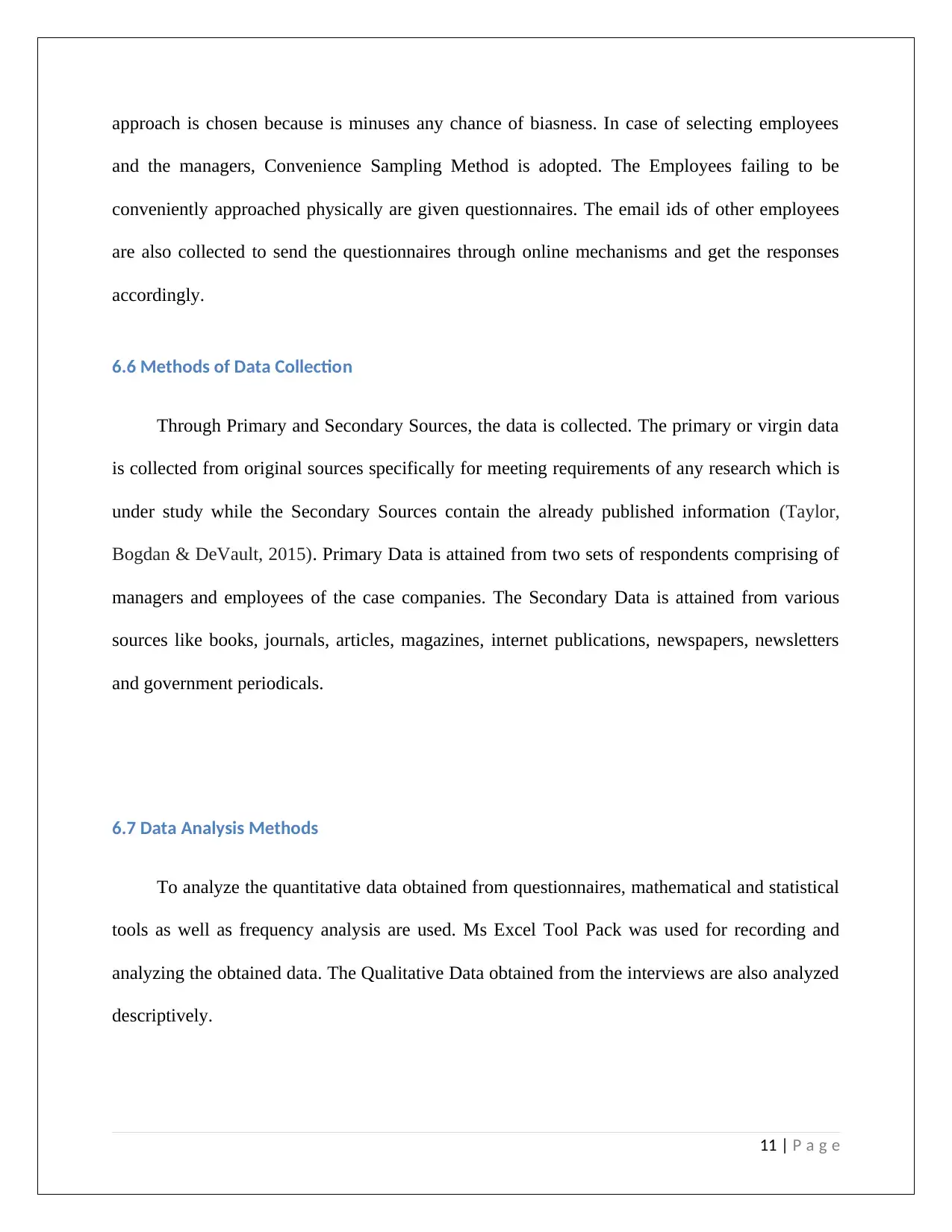
approach is chosen because is minuses any chance of biasness. In case of selecting employees
and the managers, Convenience Sampling Method is adopted. The Employees failing to be
conveniently approached physically are given questionnaires. The email ids of other employees
are also collected to send the questionnaires through online mechanisms and get the responses
accordingly.
6.6 Methods of Data Collection
Through Primary and Secondary Sources, the data is collected. The primary or virgin data
is collected from original sources specifically for meeting requirements of any research which is
under study while the Secondary Sources contain the already published information (Taylor,
Bogdan & DeVault, 2015). Primary Data is attained from two sets of respondents comprising of
managers and employees of the case companies. The Secondary Data is attained from various
sources like books, journals, articles, magazines, internet publications, newspapers, newsletters
and government periodicals.
6.7 Data Analysis Methods
To analyze the quantitative data obtained from questionnaires, mathematical and statistical
tools as well as frequency analysis are used. Ms Excel Tool Pack was used for recording and
analyzing the obtained data. The Qualitative Data obtained from the interviews are also analyzed
descriptively.
11 | P a g e
and the managers, Convenience Sampling Method is adopted. The Employees failing to be
conveniently approached physically are given questionnaires. The email ids of other employees
are also collected to send the questionnaires through online mechanisms and get the responses
accordingly.
6.6 Methods of Data Collection
Through Primary and Secondary Sources, the data is collected. The primary or virgin data
is collected from original sources specifically for meeting requirements of any research which is
under study while the Secondary Sources contain the already published information (Taylor,
Bogdan & DeVault, 2015). Primary Data is attained from two sets of respondents comprising of
managers and employees of the case companies. The Secondary Data is attained from various
sources like books, journals, articles, magazines, internet publications, newspapers, newsletters
and government periodicals.
6.7 Data Analysis Methods
To analyze the quantitative data obtained from questionnaires, mathematical and statistical
tools as well as frequency analysis are used. Ms Excel Tool Pack was used for recording and
analyzing the obtained data. The Qualitative Data obtained from the interviews are also analyzed
descriptively.
11 | P a g e

7.0 Research Limitations
The limitation of the study lies in the fact that compared to the population size, the
sample size selected for participation in the research was too small. Henceforth, the sample
cannot be a proper representative of the entire population.
8.0 Time Schedule (Research Plan)
A time schedule was adopted based on the aim of completing the project according to
desired schedules. Each segment of the study was divided and taken into consideration to arrive
at a selected time frame that is required to complete a specific task. A Gantt chart is selected for
the purpose of deciding and depicting time schedules.
Table 1: Time Schedule by means of Gantt Chart
GANTT
CHART
Business Research
Research Outcome
10
days
20
days
30
days
45
days
60
days
75
days
90
days
105
days
Research Introduction
Objectives & Research
Questions
Literature Review
Data Collection
Data Analysis
Discussion & Findings
Conclusion &
Recommendations
12 | P a g e
The limitation of the study lies in the fact that compared to the population size, the
sample size selected for participation in the research was too small. Henceforth, the sample
cannot be a proper representative of the entire population.
8.0 Time Schedule (Research Plan)
A time schedule was adopted based on the aim of completing the project according to
desired schedules. Each segment of the study was divided and taken into consideration to arrive
at a selected time frame that is required to complete a specific task. A Gantt chart is selected for
the purpose of deciding and depicting time schedules.
Table 1: Time Schedule by means of Gantt Chart
GANTT
CHART
Business Research
Research Outcome
10
days
20
days
30
days
45
days
60
days
75
days
90
days
105
days
Research Introduction
Objectives & Research
Questions
Literature Review
Data Collection
Data Analysis
Discussion & Findings
Conclusion &
Recommendations
12 | P a g e
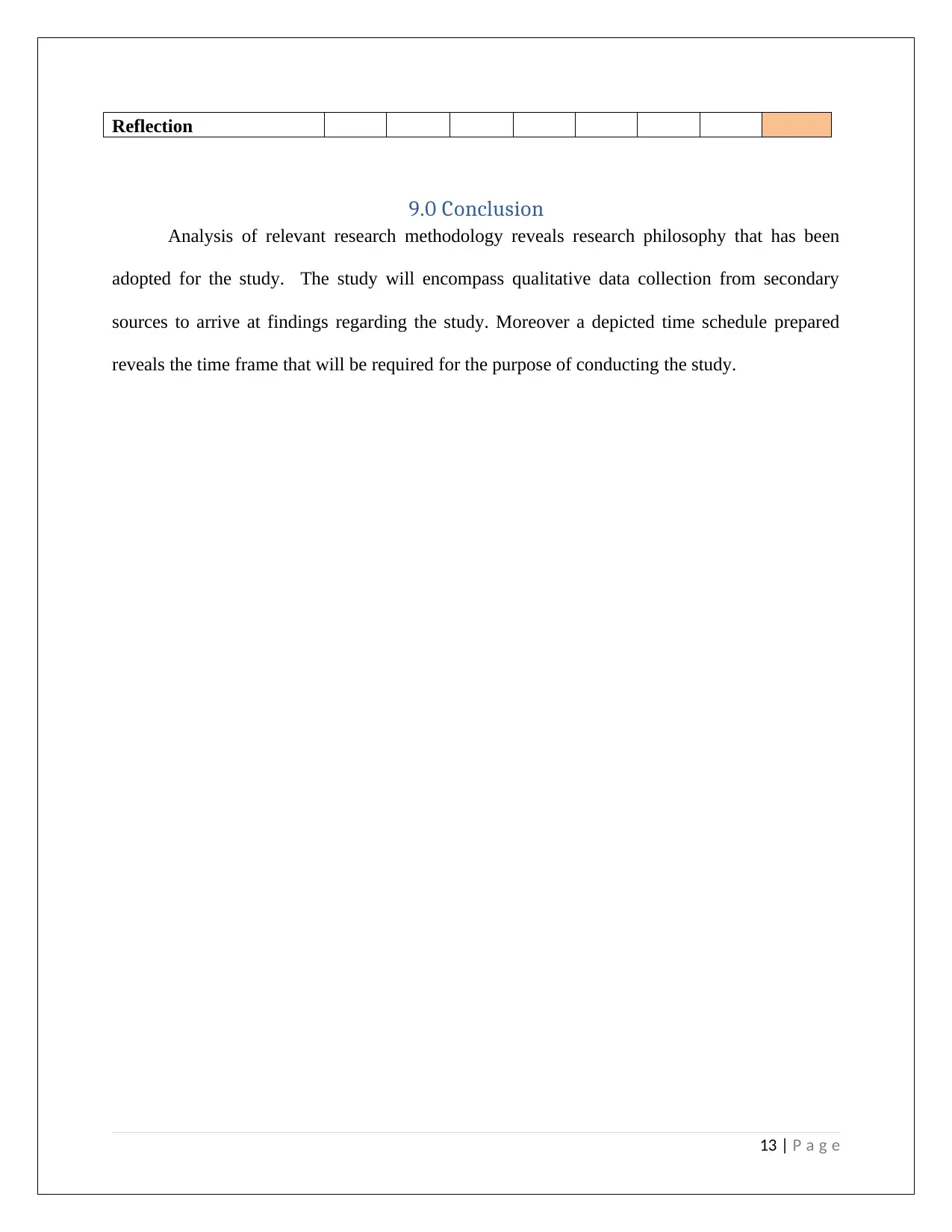
Reflection
9.0 Conclusion
Analysis of relevant research methodology reveals research philosophy that has been
adopted for the study. The study will encompass qualitative data collection from secondary
sources to arrive at findings regarding the study. Moreover a depicted time schedule prepared
reveals the time frame that will be required for the purpose of conducting the study.
13 | P a g e
9.0 Conclusion
Analysis of relevant research methodology reveals research philosophy that has been
adopted for the study. The study will encompass qualitative data collection from secondary
sources to arrive at findings regarding the study. Moreover a depicted time schedule prepared
reveals the time frame that will be required for the purpose of conducting the study.
13 | P a g e
Paraphrase This Document
Need a fresh take? Get an instant paraphrase of this document with our AI Paraphraser
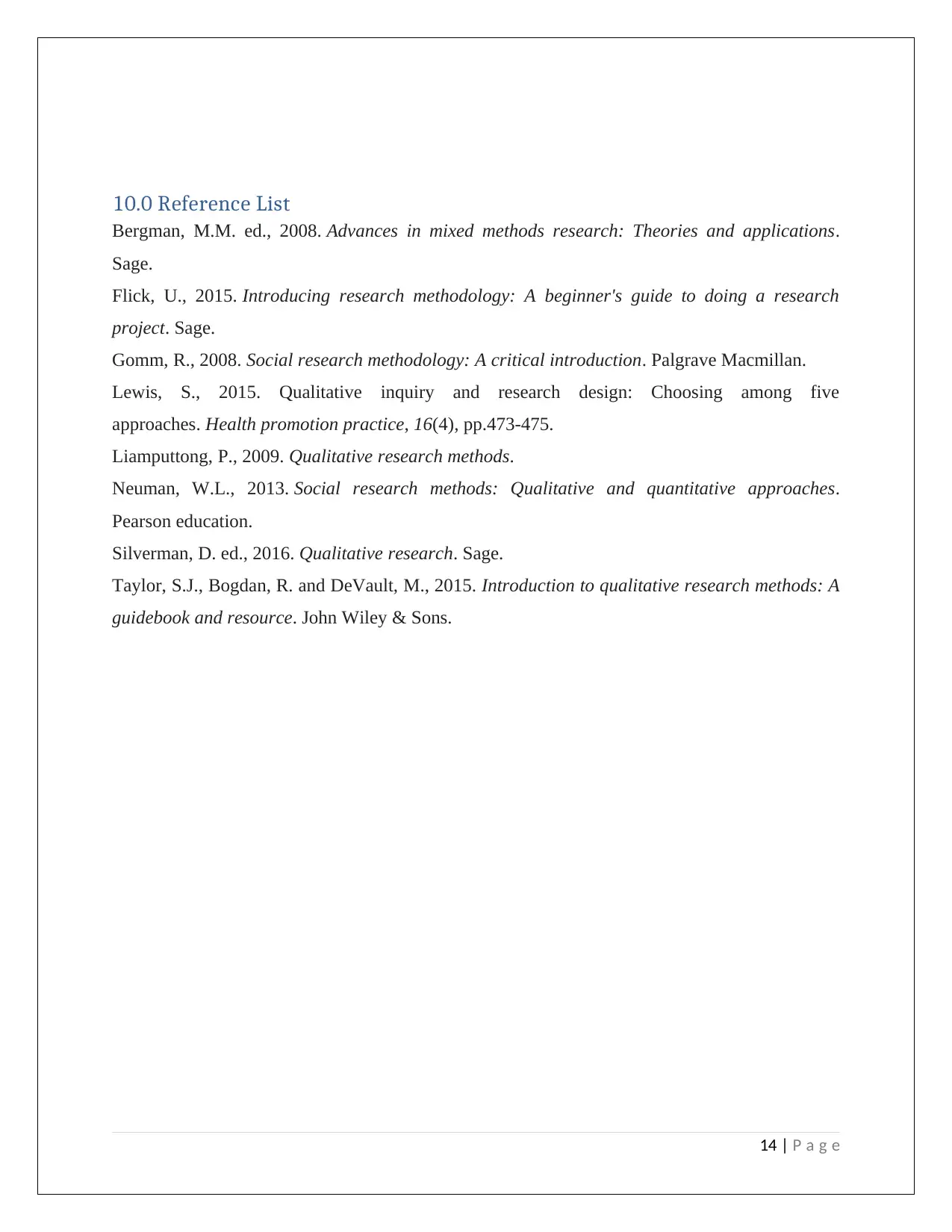
10.0 Reference List
Bergman, M.M. ed., 2008. Advances in mixed methods research: Theories and applications.
Sage.
Flick, U., 2015. Introducing research methodology: A beginner's guide to doing a research
project. Sage.
Gomm, R., 2008. Social research methodology: A critical introduction. Palgrave Macmillan.
Lewis, S., 2015. Qualitative inquiry and research design: Choosing among five
approaches. Health promotion practice, 16(4), pp.473-475.
Liamputtong, P., 2009. Qualitative research methods.
Neuman, W.L., 2013. Social research methods: Qualitative and quantitative approaches.
Pearson education.
Silverman, D. ed., 2016. Qualitative research. Sage.
Taylor, S.J., Bogdan, R. and DeVault, M., 2015. Introduction to qualitative research methods: A
guidebook and resource. John Wiley & Sons.
14 | P a g e
Bergman, M.M. ed., 2008. Advances in mixed methods research: Theories and applications.
Sage.
Flick, U., 2015. Introducing research methodology: A beginner's guide to doing a research
project. Sage.
Gomm, R., 2008. Social research methodology: A critical introduction. Palgrave Macmillan.
Lewis, S., 2015. Qualitative inquiry and research design: Choosing among five
approaches. Health promotion practice, 16(4), pp.473-475.
Liamputtong, P., 2009. Qualitative research methods.
Neuman, W.L., 2013. Social research methods: Qualitative and quantitative approaches.
Pearson education.
Silverman, D. ed., 2016. Qualitative research. Sage.
Taylor, S.J., Bogdan, R. and DeVault, M., 2015. Introduction to qualitative research methods: A
guidebook and resource. John Wiley & Sons.
14 | P a g e
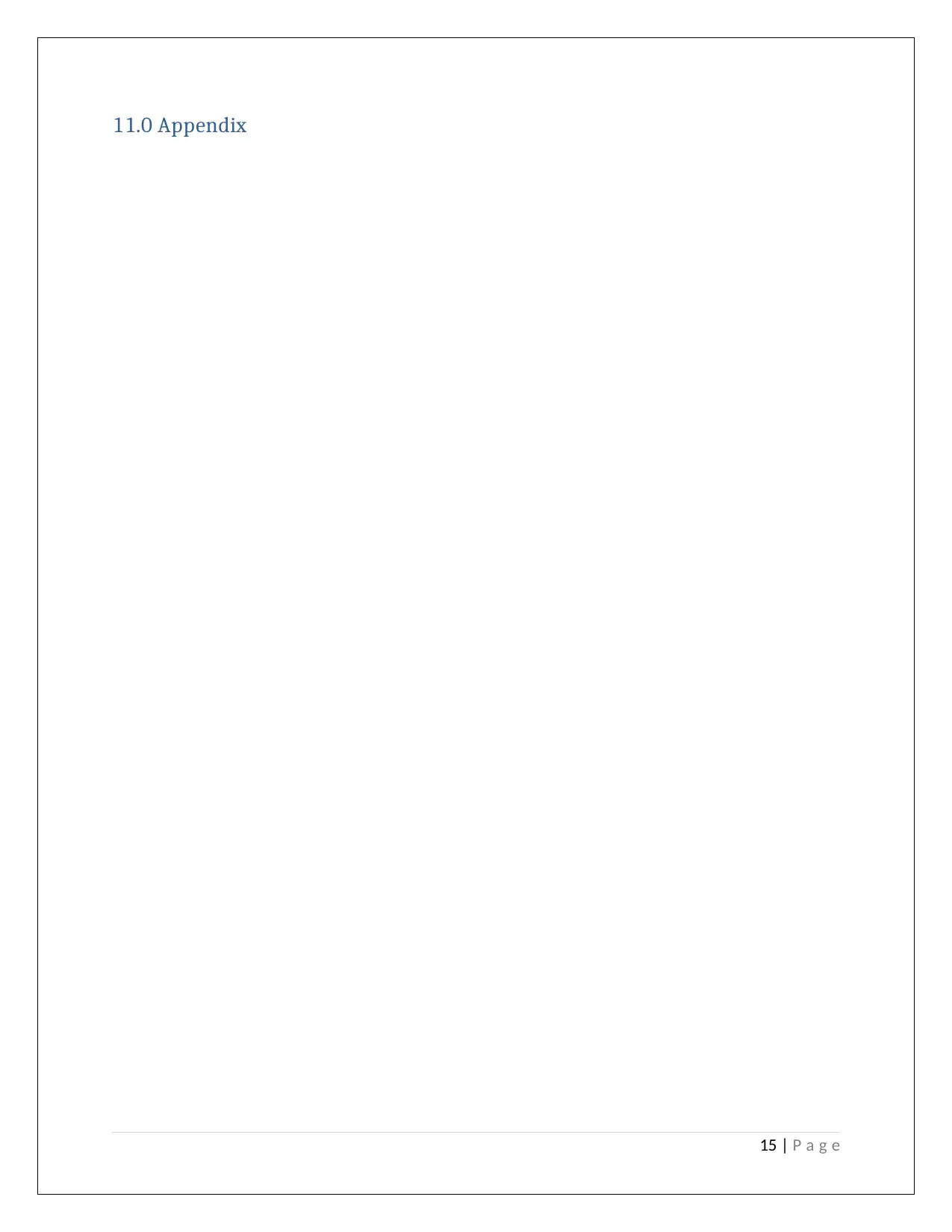
11.0 Appendix
15 | P a g e
15 | P a g e
1 out of 15
Related Documents
Your All-in-One AI-Powered Toolkit for Academic Success.
+13062052269
info@desklib.com
Available 24*7 on WhatsApp / Email
![[object Object]](/_next/static/media/star-bottom.7253800d.svg)
Unlock your academic potential
© 2024 | Zucol Services PVT LTD | All rights reserved.



